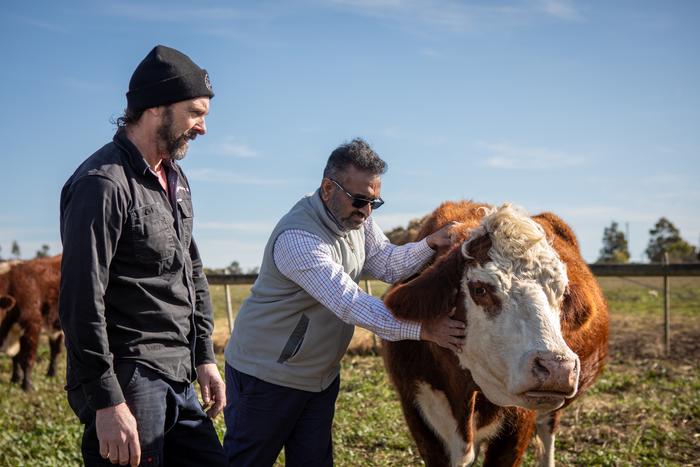Researchers warn the animals we eat could be the gateway for a pandemic in the form of antimicrobial resistance, unleashing a wave of deadly superbugs.

Credit: Ant Bragaglia, RMIT University
Researchers warn the animals we eat could be the gateway for a pandemic in the form of antimicrobial resistance, unleashing a wave of deadly superbugs.
The World Health Organization estimates that drug-resistant diseases could cause up to 10 million deaths each year by 2050.
The researchers analysed this public health and food security challenge in the food animal industry in Southeast Asia for the International Journal of Food Science and Technology.
This challenge is relevant to Australia, which has strong political, economic and social ties with countries in the region. Australia marked 50 years of engagement with the Association of Southeast Asian Nations (ASEAN) at a special summit in Melbourne earlier this year.
Bioscientist Professor Rajaraman Eri and microbiologist Dr Charmaine Lloyd from RMIT University in Australia and public policy expert Dr Pushpanathan Sundram from Thailand co-wrote the journal article.
“There is a big pandemic waiting to happen in the form of antimicrobial resistance,” said Eri, who is the Associate Dean of Biosciences and Food Technology at RMIT and also a veterinarian.
“We’re going to face a situation in the world where will run out of antibiotics. That means we will not be able to treat infections.”
Asia is a hotspot of antimicrobial resistance in animals, with Southeast Asia being an epicentre, the team says.
There are more than 2.9 billion chickens, 258 million ducks, 7 million cattle, 15.4 million buffaloes, 77.5 million pigs, 13.7 million sheep and 30.6 million goats in the region, according to the Food and Agriculture Organization.
“Livestock farming, mainly for smallholders, provides employment and side income, improves household dietary components and nutritional security, and provides food and economic wellbeing for their respective nations,” said Sundram, who contributed to the research while he was at Chiang Mai University in Thailand.
The research paper highlights the Southeast Asia’s challenges associated with antimicrobial resistance and residue in animals, and points out the need to differentiate the two concepts.
Resistance occurs when microorganisms develop resistance to antimicrobial agents to which they are exposed.
“On the farm, the presence of antibiotics in food, soil, water run-off and animal waste can contribute to this resistance developing,” said Lloyd, from RMIT’s School of Science.
“The overuse and misuse of antimicrobial drugs, especially for growth promotion in healthy animals, have resulted in the increased rate of resistance.
“Since resistant bacteria in animals may be transferred to humans through the food chain or by direct contact, this transmission pathway highlights the connection between human and animal health, emphasising the need to address antimicrobial resistance in food animals.”
Food animals’ residues are remnants of drugs, pesticides and other chemical substances that persist in animal tissues or products after administration or exposure to these substances.
“Veterinary drug residues commonly arise from overusing and improper use of antimicrobial agents, growth promoters and other veterinary drugs in animal husbandry practices,” Eri said.
“Efforts in the region to regulate antimicrobial use are underway, but there’s growing concern over consuming products with antimicrobial residues, which can impact human health due to the presence of antibiotic-resistant microbiota and pathogens in hosts,” Sundram said.
“In Australia, we have excellent policies to take care of antimicrobial resistance, specifically, the usage of antibiotics is well regulated,” Eri said.
“But that’s not the case at the global level. In many countries, anybody can buy antibiotics, whether it be for human or animal use.”
The team has six recommendations for policymakers in ASEAN countries to address antimicrobial resistance and residue in food animals:
1. Recognise the difference between residue and resistance, to tackle the resistance challenges with the right interventions in Southeast Asia’s food animals.
2. Collaborate regionally and develop tailored strategies to navigate disease outbreaks, environmental concerns, residue levels and antimicrobial resistance.
3. Implement country-specific awareness campaigns, robust surveillance of residues and resistance, appropriate regulations and responsible antimicrobial use, to reduce resistance risks.
4. Foster international cooperation and initiatives to address resistance comprehensively, ensuring a united front against both residue and resistance.
5. Strengthen public health systems and preparedness.
6. Promote innovation and research in alternative antimicrobial solutions, sustainable farming practices and advanced diagnostics, to stay ahead of evolving challenges.
‘Addressing residue and resistance in food animals: a policy imperative in Southeast Asia’ is published in the International Journal of Food Science and Technology (DOI: 10.1111/ijfs.17063). Once the embargo lifts, the article will be available at this link:
MULTMEDIA FOR MEDIA USE
Here’s our unlisted youtube video:
We’ll make it public when the paper is published.
Here’s our multimedia associated with the story:
The photos and video were taken at the farm and home of Chris Balazs, farmer and CEO of Provenir. He’s wearing the beanie in all of the photos.
The other person in the photos is RMIT University Professor Rajaraman Eri, a co-researcher of this study.
Please credit all photos and video to Ant Bragaglia, RMIT University.
Journal
International Journal of Food Science
Method of Research
Commentary/editorial
Subject of Research
Not applicable
Article Title
Addressing residue and resistance in food animals: a policy imperative in Southeast Asia
Article Publication Date
21-Aug-2024



